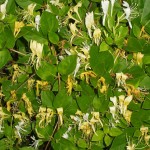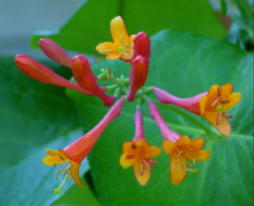It”s Blooming now , go harvest for your winter Viral infections
First thing you need to do is go find a “safe” honeysuckle patch that is blooming right now. Ours is just beginning to blossom. The one you want is the kind that blooms white then turns yellow. Gather as many blossoms (blossoms only no green stuff) as you can during the season.
Dry them. Air dry them not dehydrate them. When they are good and dry put them in a dark jar and leave them until winter. These blossoms are MULTI viral. Which means that when you get that flu shot the doctor gives you the virus that is common for the flu they are guessing you are going to get. What you need is a multi viral that will kill ALL virus that it comes in contact with. When the flu hits you take out your little brown jar or big brown jar.
Take a teaspoon of the dried blossoms and put them into a cup. Add boiling water, cover with a saucer and let steep for 10 minutes (infusion). You can strain off the blossoms if you want but since they are edible you can also snack on them after drinking the tea. Sweeten the tea and drink as hot as you can. Repeat later in the day if necessary. We have found that only two cups will get rid of the flu or virus.
Botanical: Lonicera caprifolium (LINN.), Lonicera Periclymenum (LINN.)
Family: N.O. Caprifoliaceae
Synonyms—Dutch Honeysuckle. Goats” Leaf.
(French) Chèvre-feuille.
(German) Geissblatt.
(Italian) Caprifoglio.
Parts Used—Flowers, seeds, leaves.

Caprifoliaceae, the order to which the Honeysuckles belong, includes about 300 species, chiefly shrubs, growing in the north temperate zone or extending into the higher cool tropical regions. Besides the Viburnums and Sambucus, a number have found more or less important uses in medicine, but they exhibit but little uniformity in composition or properties.
Medicinal Action and Uses—A dozen or more of the 100 species of Lonicera or Honeysuckle are used medicinally, the fruits generally having emetic cathartic properties. Several of these drugs have more than a local repute.
The herbage of L. caprifolium (Linn.), the smaller, or ITALIAN HONEYSUCKLE, of Mid- and Southern Europe, is used as a cutaneous and mucous tonic and vulnerary and the seeds as a diuretic.
L. Periclymenum (Linn.), our common ENGLISH WILD HONEYSUCKLE, is used similarly and the stems as a substitute or adulterant for Solanum Dulcamara, the Bittersweet.
Waller says: ”The leaves and flowers of Honeysuckle are possessed of diuretic and sudorific properties,” and adds: ”a decoction of the flowers has been celebrated as an excellent antispasmodic and recommended in asthma of the nervous kind. An elegant water may be distilled from these flowers, which has been recommended for nervous headache.”r
Gerard says: ”The Honeysuckle is “neither cold nor binding, but hot and attenuating or making thin.” ” He quotes Dioscorides as saying that: ”the ripe seed gathered and dried in the shadow and drunk for four days together, doth waste and consume away the hardness of the spleen and removes wearisomeness, helps the shortness and difficulty of breathing, cures the hicket (hiccough), etc. A syrup made of the flowers is good to be drunk against diseases of the lungs and spleen.” He also recommends it for sores in various parts of the alimentary canal.
Salmon in his Herbal (1710) speaks only of the Meadow Honeysuckle, ”which was the name given by the agriculturists of his day to the Meadow Trefoil (Trifolium pratense).”
The herbage of the true Honeysuckle is a favorite food of goats, hence the Latin name Caprifolium (Goats” Leaf), the French Chèvre-feuille, German Geisblatt and Italian Capri-foglio, all signifying the same. The berries have been used as food for chickens. The name of the genus, Lonicera, was given by Linnaeus in honor of Adam Lonicer, a physician and naturalist, born at Marburg in 1528, who wrote, among other works, the Naturalist Historiae Opus novum, which contains much curious information about plants.
Our native Honeysuckle has expectorant and laxative properties. The flowers in the form of syrup have been used for diseases of the respiratory organs and in asthma and the leaves as decoction in diseases of the liver and spleen. It was also considered a good ingredient in gargles.
L. tartarica, a native of Siberia, an upright species, a shrub, not a climber, has berries which are nauseously bitter and purgative.
The wood of L. Xylosteum, native of Eastern Europe and Asia, but found naturalized in Sussex, also of shrub-like nature, is used by the Russians to prepare an empyreumatic oil for ”cold tumors and chronic pains. ” It is sold in China as Jin-tung. Animals seldom touch the leaves of this species and birds eat its berries only in hard weather – they are reputed to be purgative and emetic.
L. brachypoda repens is used in Japan as a drastic purgative, and L. Japonica (Thunb.) is sold in China as Kin-yin-keva.
Diervilla, the Bush Honeysuckle, especially Diervilla Diervilla (L. Diervilla, Linn.), has a similar repute, especially as a diuretic and as an application to relieve itching.
Various species of Symphoricarpus, Snowberry, Wax-berry, Coral-berry, Indian Currant, Turkey-berry, Wolf-berry, to give a few of its names, of North America, are similarly employed. S. racemosa (Mich.) is often planted in hedges.
Culpepper says: ”Honeysuckles are cleansing, consuming and digesting, and therefore no way fit for inflammations. Take a leaf and chew it in your mouth and you will quickly find it likelier to cause a sore mouth and throat than cure it. If it be not good for this, what is it good for? It is good for something, for God and nature made nothing in vain. It is a herb of Mercury, and appropriated to the lungs; the celestial Crab claims dominion over it, neither is it a foe to the Lion; if the lungs be afflicted by Jupiter, this is your cure.
It is fitting a conserve made of the flowers should be kept in every gentlewoman”s house; I know no better cure for the asthma than this besides it takes away the evil of the spleen: provokes urine, procures speedy delivery of women in travail, relieves cramps, convulsions, and palsies, and whatsoever griefs come of cold or obstructed perspiration; if you make use of it as an ointment, it will clear the skin of morphew, freckles, and sun burnings, or whatever else discolors it, and then the maids will love it. Authors say, the flowers are of more effect than the leaves, and that is true: but they say the seeds are the least effectual of all. But there is a vital spirit in every seed to beget its like; there is a greater heat in the seed than any other part of the plant; and heat is the mother of action.”
Honeysuckle Vine
A honeysuckle vine is a woody vine with leaves, which are from 1 to 3 inches long. The flowers of the honeysuckle vine are tube-shaped, about 2″ long, and range from white to bright yellow in color. The honeysuckle vine produces fruit, which are orange or red berries about a quarter of an inch large.
The honeysuckle vine is a climbing vine that can grow to as much as twenty-five feet in height. Honeysuckle vines generally flourish in zones 4 through 8. The usually fragrant flower blooms during summer and fall. The honeysuckle vine generally prefers full sun and normal water conditions.
Honeysuckle vines are also very popular to animals. Butterflies and hummingbirds feed off the flower. Birds eat the fruit produced by honeysuckle vines, and deer feed off the leaves year round.
A honeysuckle vine would be a great addition to any garden. The vine will spread quickly and cover just about anything in its path. A honeysuckle vine will add a touch of color to otherwise dull fences and walls. The scent emitted from the flower of the honeysuckle vine will drift through the air for all to enjoy.[align=center] [/align]
How to Prepare Honeysuckle Vine for Weaving Honeysuckle produces a light-gold to light-brown vine once the outer bark is removed. The woody vine climbs or trails along the ground.
Steps:
1. Use honeysuckle as an accent when weaving a melon or egg basket and as a material to lash a basket together.
2. Gather vines. Honeysuckle vines are thin, and it will take a large amount to make a basket.
3. Coil vines in loose coils and discard badly damaged vines. Coil longer runners together and short ones together to be used on different parts of the basket.
4. Boil water in a large pan. We suggest a #2 washtub on a camp stove outside to prevent a mess in your kitchen.
5. Place coils in boiling water and boil for 10 to 30 minutes or until the outside bark peels away easily.
6. Remove coils from hot water with a pair of barbecue tongs. Wear gloves to prevent burns from splashing water.
7. Cool coils until you can easily handle them.
8. Remove outer bark with a plastic scrubber. You can use a knife to gently scrape stubborn bark.
9. Hang stripped vine up to dry and to prevent molding.
10. Coil and store until needed.
Tips:
Stored honeysuckle vine can be soaked in warm water to make it pliable and ready to use.
Honeysuckle can be gather at any time of the year.









